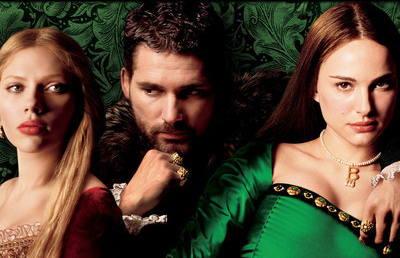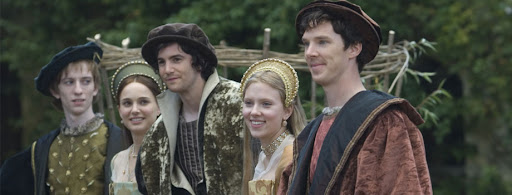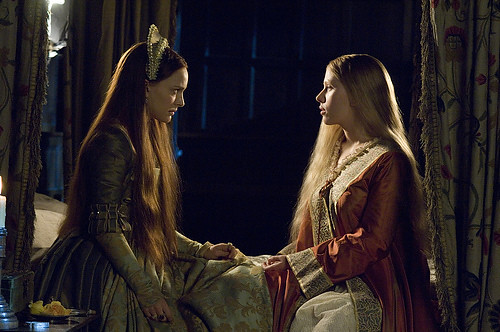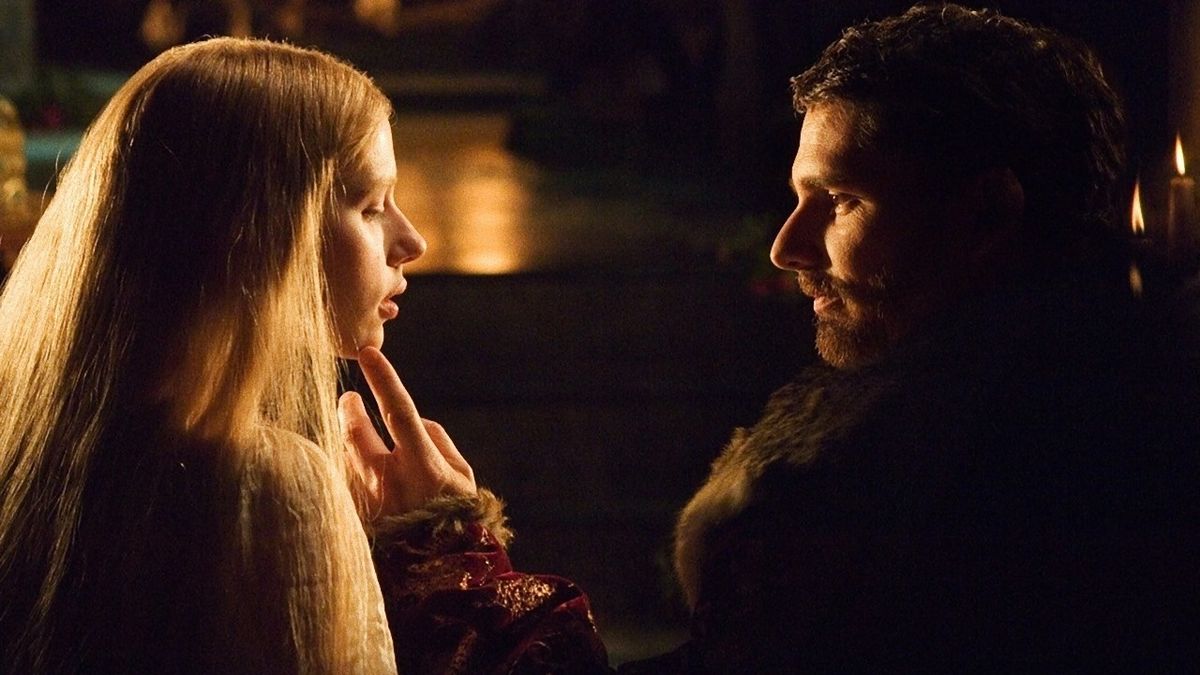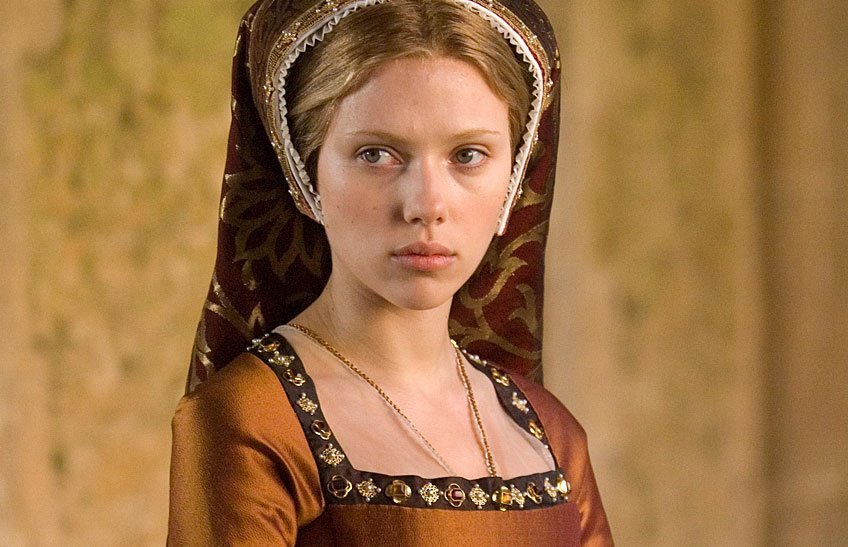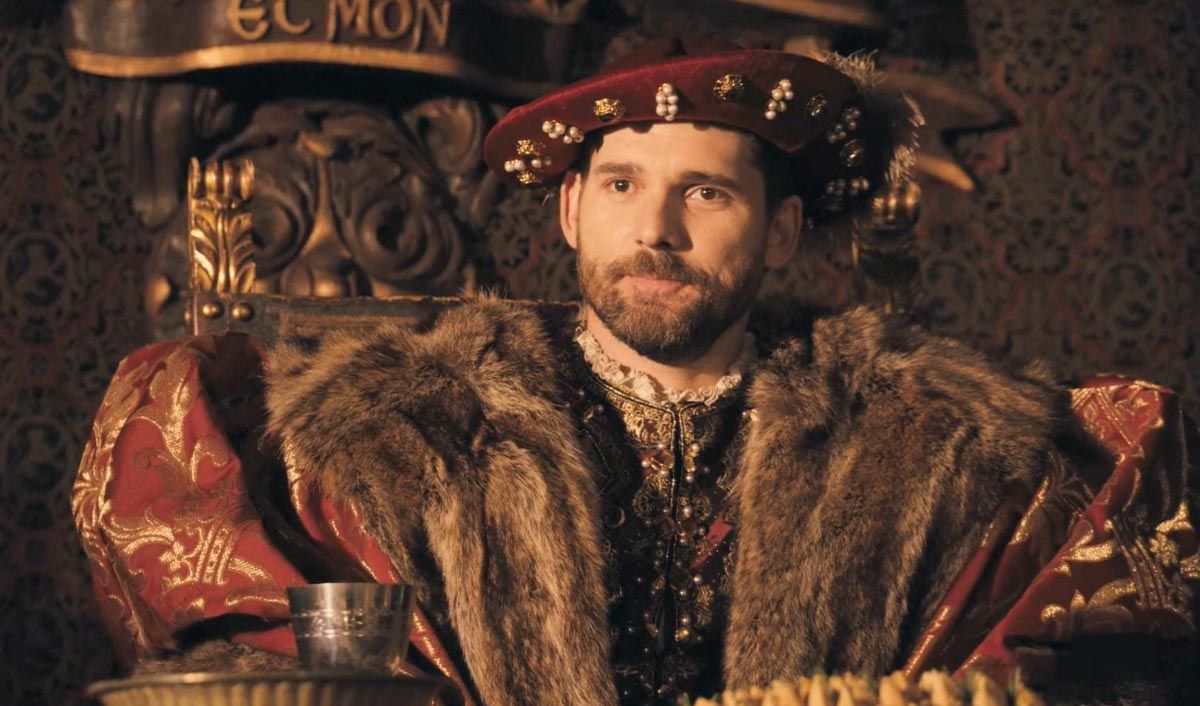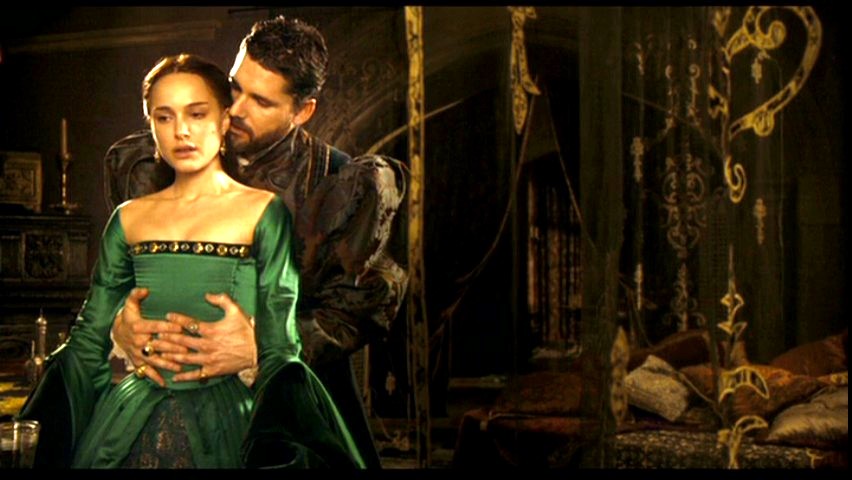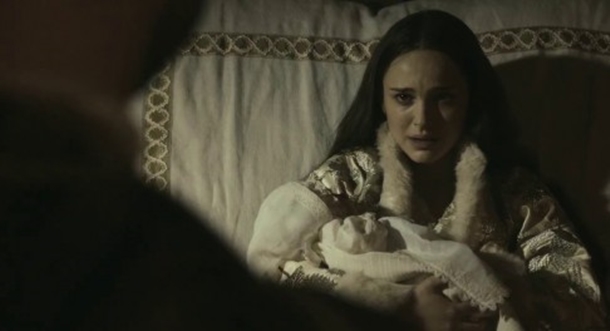Philippa Gregory’s The Other Boleyn Girl written in 2001 arguably turned an entire generation onto historical fiction. It prompted a slew of novels written about the royal court, specifically the overlooked women who are forever relegated to the sidelines. The Other Boleyn Girl follows the life of Mary Boleyn, the lesser known sister of Anne Boleyn, Henry VIII’s second wife. Mary herself led an exciting and interesting life, one that didn’t end with her execution and saw her as the only Boleyn child to survive her sister’s fall from favour. She was the mistress of two kings, including Henry VIII, and after the death of her first husband, she defied convention by marrying for love.
The Other Boleyn Girl (2008) was actually the second film to be made of the book. The first was a television drama made by the BBC on a much lower budget and while I’d argue is the better of the two versions, attracted criticism for presenting the story through a style reminiscent of reality tv. The 2008 version however was a big Hollywood production starring Eric Bana, Natalie Portman, and Scarlett Johansson. But the script used the novel upon which it was based as a broad guide rather than something to follow. Thus, where The Other Boleyn Girl novel is fiction, The Other Boleyn Girl 2008 film is a fictional take on fiction and the result is a mess of things that didn’t happen in a time line that doesn’t make sense. There is very little resemblance to the novel and even less to history.
Before we pick apart the rather broad inaccuracies of the film, an important thing to note is that the events of the film took place broadly over a fifteen year period but the film condenses the events to a much smaller time frame. This is hardly new in the world of historical fiction, but the film doesn’t indicate where time is passing of has passed. As a result, there’s no tangible timeline of events and the whole thing seems to take place over just a few years even considering the handful of pregnancies represented.
The Family Boleyn
The Film: We begin with an introduction to the Boleyn family. We have Thomas Boleyn, his wife Elizabeth, and their three children; Anne, George, and Mary. Anne is the oldest. You wouldn’t think this would be particularly noteworthy but it is repeated again and again and again. Anne is the oldest sister, Mary the younger. George is also present but as a boy and the natural heir, his age is unimportant.
The Boleyns live at the family seat at Rochford and are a very close knit, happy family. Elizabeth is the sister of the Duke of Norfolk but she gave up her position and status when she fell in love with Sir Thomas Boleyn. Her family connections remain strong however and the Duke of Norfolk is a regular visitor who is known to have the king’s ear.
Thomas and Elizabeth muse on the good qualities of their children. Mary is quiet, sweet, and kind, whereas Anne is headstrong, spirited, and wilful. Anne is the clear favourite while Mary is the easily overlooked but gentler of the two. Fearing that Mary’s nature might see her fall back in life, Thomas Boleyn decides to offer her in marriage to the family of William Carey even though they have enquired after Anne.
In History: The Boleyn children were probably born at Blickling Hall which was the Boleyn’s primary residence until the early 1500s when they moved to Hever Castle. Rochford Hall did belong to Thomas Boleyn but it isn’t thought that they maintained it as their primary residence. In terms of age, it’s generally accepted, though disputed by some, that Mary Boleyn was the elder sister. Anne Boleyn’s date of birth is unknown but commonly believed to be in 1501, while Mary was roughly two years older. Much of the evidence regarding the ages of the Boleyn children comes from much later in the Tudor reign, under Elizabeth I in various papers regarding Mary Boleyn’s children. Claims were made to inheritances which could only have been granted if Mary was the eldest child. We know that George was certainly the youngest, and the only surviving son. Two other boys, Thomas (born between Mary and Anne) and Henry (born between Anne and George) died before their teens.
Thomas Boleyn had indeed made an advantageous marriage in Elizabeth Howard, though it can’t be said it was down to her casting off the constraints of her position and marrying for love. Elizabeth was the eldest daughter of the second Duke of Norfolk, however she was the ninth of seventeen children. She was the first of two daughters to be named Elizabeth, so while she carried the grand Howard name, as an heiress her position was weak to say the least.
The Howards might have been one of the most prominent families at court but under Henry VII their fortunes had fallen somewhat. They’d fought with Richard III at the Battle of Bosworth which saw them put under attainder for the initial part of Henry Tudor’s reign. Thomas Boleyn by contrast was a rising star at the Tudor court and was actually a good name for the Howards to ingratiate themselves with. He may not have carried the prestige of a grand and noble name but it would be unfair to suggest that the Howards gained nothing from the marriage.
Also, the Carey family hadn’t offered marriage at this point. Neither to Anne or Mary.
Mary Boleyn & William Carey
The Film: The Carey family obviously accept Mary Boleyn as an alternative wife for their son William and now that the children are adults, the time has come for Mary and William to be married. In case you had missed the order in which the Boleyn girls were born, Anne greets Mary as, “younger than me, more beautiful than me. I am eclipsed. I am the other Boleyn girl.” She later says that she has “failed as an elder sister,” because she can’t tell Mary what to expect on her wedding night. They are really pushing the Anne is the elder sister theory. As the eldest child of my own family, I can confirm that I only ever greet my siblings with a reminder of the order in which we were born.
As for the wedding itself, we are introduced to William Carey played by Benedict Cumberbatch (who at this point is a baby). Mary and William are shown to be completely and totally happy despite the newness of their marriage. While William apologises for not being a great or grand noble, he promises to love Mary which she assures him is all she desires. Their wedding night is nothing to write home about but they’re happy together. Aww.
Against the backdrop of the wedding, some other events of significance are shown to us. Katherine of Aragon is seen delivering a stillborn son. Her daughter Mary is beside her and Katherine laments that there will be no heir and safety for England with this loss. The physician goes to find Henry VIII and announces to him, in front of the entire court, that the child has been born dead. The Duke of Norfolk hears all this and immediately departs for Rochford where the wedding is in full swing.
Norfolk tells Boleyn that Henry will inevitably take a mistress and that it’s up to them to put someone in Henry’s way before one of the other families can secure his attention. To Norfolk’s surprise, Boleyn offers Anne. “Your firstborn?” he asks incredulously, in case we had forgotten over a few minutes that Anne is the elder child in this. The two resolve to put it to Anne who is outside flirting with Lord Henry Percy of Northumberland even though he is already precontracted elsewhere and could surely never land such a match.
In History: Something the film makes no mention of is Mary Boleyn’s time in France which is kind of important. Mary grew up in the French court in service to the queen and while she was there, at some point, she became the mistress of the French king. She returned to England in 1519 where she became a maid of honour to Katherine of Aragon. Incidentally, Katherine had delivered the last of her children in 1518, a stillborn daughter. Princess Mary was herself an infant and wouldn’t have been in attendance on her mother while she laboured.
Mary was married to William Carey in 1520 and it was not a marriage of small account. Mary was a lady in the queen’s retinue while Carey was a prominent member of the king’s household, as well as a personal friend of Henry. Though it’s been speculated that the marriage was made and attended by Henry so that he could cover his affair with Mary, there’s no evidence to suggest that this was the case. Carey was much favoured by the king and as both husband and wife were prominent courtiers, it would make sense for Henry to attend.
Mary and Carey were already at court and had no intention of retiring to the country. Mary wasn’t marrying beneath her station, and in many ways, given her conduct in France, was lucky to land a match to such a well connected man. It’s unlikely that Carey (or the king for that matter) knew of her affair and she likely wouldn’t have made such a good marriage if it was common knowledge.
At the time of the wedding, Anne was still in service at the French court and wasn’t present. Nor could she have caught the eye of Henry Percy who probably wasn’t in attendance either.
Anne and the King: Round One
The Film: The Duke of Norfolk arranges a visit to Rochford by the king to pay his respects to the Boleyn family. Although initially opposed to becoming the king’s mistress, Anne relents when it’s made clear that she can marry well after the fact and that the king will ensure her a good marriage, far higher than she could have attained under normal circumstances. The family push Anne into Henry’s attention and he immediately begins flirting with her.
Anne dresses to match the king, sits beside him at dinner, and generally makes herself enchanting to him. Plans are made for them to lead a hunting party into the countryside though Anne surprises Henry when she reveals that unlike the other women attending the hunt, she will ride alone without a man to hold onto. When Henry questions her how she possibly intends to ride a horse without a man’s involvement, Anne introduces him to a new type of side saddle that not only allows her to ride alone but will allow her to keep up with him.
The hunt runs late and returns slowly for the sake of an injured person. We are introduced to William Stafford (and if you think Benedict Cumberbatch is young in the film, wait til you see Eddie Redmayne), one of Boleyn’s servants who tells the family that the stag they were hunting managed to elude them but Anne refused to give up and jumped a dangerous ravine. Not wishing to be outdone, the king followed but fell from his horse and was injured. Anne has thus completely blown any chance she had to impress the king and instead, Mary is asked to tend the injured Henry.
In History: This entire scenario is fictional. Anne was still at the French court, Henry did not visit in order to be seduced by the Boleyn’s choice of mistress, and there was no ill-fated hunt that ended in injury. Surely then, I hear you say, we will move on but not so fast. Let’s talk about Anne’s side saddle.
That’s right, I’m not above picking apart the history of a saddle. Women at the time did not need to ride with men. This was not something that happened. Women could be capable horsewomen and while side saddle was preferred, riding astride was not the social death we think it to be. It was, in fact, the only practical way woman could ride competitively. Part of Anne Boleyn’s appeal was how great a sportswoman she was and how she could keep up with Henry on hunts, something she wouldn’t have been able to do riding side saddle which limited the mount to a sedate pace. Although this hunt didn’t happen, those that did would have seen Anne riding astride, like a man (gasp!) rather than on a side saddle that wasn’t invented until after her death.
Mary and the King
The Film: After being unconscious for half a day and the evening, Henry wakes to discover Mary tending his injuries. Immediately enraptured, he plies Mary with questions including how he could possibly have overlooked her. She tells him of her husband and their wish to remain in the country, at least while they start a family.
The following morning, Henry leaves without so much as a word to Anne but a longing look at Mary, which Anne doesn’t fail to notice. Boleyn and Norfolk then announce that Mary has been invited to court, with Henry securing her a position as lady in waiting to his wife, Katherine of Aragon. Mary protests and appeals to her husband, saying that the last thing she wants to do is attend court and become the king’s mistress. Her husband, visibly distraught, says nothing as Norfolk tells them that he too will be attending court as a Gentleman of the Privy Chamber.
The family go off to court where Mary is presented to the queen. Anne goes with her, even though she hasn’t been given a position, and watches as Katherine humiliates Mary in front of the other ladies. After her embarrassing introduction, Mary is approached by Jane Parker, another lady in Katherine’s retinue who assures her that Katherine is a good mistress and she’s just a bit put out that Henry’s been appointing his mistresses into her household.
Mary catches a moment with Stafford where he admits he’s feeling homesick and tells her that Anne has once again been linked to Henry Percy. That evening, while Anne schemes to get a ring from Percy, Henry finds Mary and tells her that he’s going to sleep with her that night. Across the room, Carey looks as distraught as Mary does but he doesn’t voice his problems and slinks off.
That night, Mary meets Henry in private for the first time. She’s a little nervous until he tells her that he knows what it’s like to be the second child, “forever in the shadows” of their elder sibling. One kiss later and Mary is completely besotted. They fall into bed together and pass the night away in each other’s arms. Come morning, Stafford is waiting just outside the door to escort Mary to Norfolk, her parents, and her husband where she faces a grilling about her night with Henry. Norfolk announces his intention for Mary to fall pregnant and give Henry a male heir.
Initially, Mary is reticent but she’s already half in love with Henry already and it really doesn’t take much for her to fall the rest of the way. One night, Henry asks if she’d mind terribly if he sent her husband away. Mary does not protest and we see that she is no longer conflicted about being the king’s mistress.
In History: We’ve already established that Mary and her husband were not reluctant visitors to court, and that the hunt injuring Henry didn’t happen. While little is known of Henry and Mary’s affair, which was conducted with such discretion that for a long time nobody knew if it had even happened, we can say with certainty that it would have started at court.
There is evidence to suggest that their affair began in 1522 and ended three or four years later. Because of the manner in which it was conducted, it’s difficult to gauge reactions to the liaison. What we do know for sure is that Mary and Henry had an affair and her husband continued to be well regarded at court. William Carey wasn’t sent away at any point and presumably, Mary and William continued to sleep together as the king lay no claim to Mary’s children.
We also don’t know Mary’s feelings towards Henry or the affair. Her time with the King of France doesn’t necessarily mean she was raring to jump into another royal bed. She also may not have had much of a choice. Her personal feelings would have counted for very little, she would hardly have been in a position to have turned the king down even if she wanted to. Not that her family benefitted in any real or tangible way from her position. What grants and gifts were conferred upon her husband and family might well have been the result of their own closeness to the king rather than a placating gesture.
Anne and Henry Percy
The Film: While Mary falls deeper in love with Henry, Anne has totally captivated Henry Percy and married him in secret. The two sneak out, are married by a priest, and then return to consummate the marriage. The following morning, George bounces into Mary’s room and excitedly tells her that Anne will be the Duchess of Northumberland. Aghast that Anne would risk her reputation in such a way, she resolves to immediately snitch on her to her father and uncle.
Anne and Percy are brought before Boleyn and Norfolk who give them a stern talking to. Percy says exactly nothing during the entire exchange as her family rails at their irresponsibility. As heir to one of the larger earldoms in the kingdom, Percy has run the risk of treason by marrying without approval, and Anne for participating. Anne insists that if the family support her then the marriage will be valid and the family will benefit from her position. Norfolk tells them not a chance and tells Percy to get the hell out so he can marry the woman his father has chosen for him. Percy, again without a word, leaves. Anne is shocked that her husband could abandon her, and distraught when her father tells her she’s such a disgrace she’ll have to go to France in exile.
Her mother takes her aside and tells her that she played her cards wrong, and that the art of being a woman is to let men think they’re in charge, something she will learn at the French court. Before she leaves, Anne confronts Mary about her treachery. Mary insists that she would have been ruined otherwise and acted to preserve Anne’s reputation. Anne believes the opposite and that Mary only reported her so that Anne would be sent away and Mary wouldn’t have to deal with having her older, prettier sister around.
The two aren’t speaking when Anne leaves for France the following morning, George is also narked that he’s lost one of his sisters, and as Mary weeps, she realizes that she’s pregnant.
In History: While Henry and Mary conducted their affair behind closed doors, Anne Boleyn was establishing herself as a glittering courtier. Henry Percy was indeed among her admirers though as heir to one of the most prominent Earldoms in the country, and already betrothed to the daughter of the Earl of Shrewsbury, she was never a likely prospect for him.
Nevertheless, an understanding was reached between the two. How far such an understanding went is up for debate but it seems that Percy and Anne exchanged a promise that they would be married. When news of this reached Cardinal Wolsey, Percy’s patron at court, he summoned Percy and apparently proceeded to give him the dressing down of a lifetime. The result was Percy being returned immediately to his equally incensed father who rapidly finalised the details of his existing betrothal.
We have only one source for this encounter and it isn’t the most reliable. The author, George Cavendish, included it in his biography of his master, Thomas Wolsey. He speculates that the king had Wolsey break off the arrangement so that he could pursue Anne himself but it’s more likely that Wolsey acted to preserve etiquette. The marriage between the Earl of Northumberland was a matter of state and not to be left in the hands of Percy himself. Although Anne was establishing herself as a central figure at court, she was still only the daughter of a minor noble and couldn’t contend with a woman of Mary Talbot’s breeding in terms of arrangement. Finally, negotiations were being made for Anne’s own marriage elsewhere into the Butler family. In short, neither were particularly free to offer the other marriage, it wouldn’t have been allowed even if they were, and their betrothal, however informal, raised issues for the existing marriage negotiations.
We can assume then that unless Anne was particularly careless, and her later behaviour suggests that she was not, she did not have sex with Henry Percy. As ambitious as she may have been, it would have been an incredible risk to have lost her virginity to a man who couldn’t have promised her marriage beyond a doubt. It may have been a consideration if she had her family and the Duke of Norfolk were willing to support the match but there’s no evidence that she had even approached them.
When they found out, Anne was not sent away in disgrace to the French court. She had, in fact, only recently returned from her time in service there. Mary didn’t report the possible affair to her family, though she may well have fallen pregnant around this time.
Mary’s Pregnancy
The Film: Norfolk tells the king that Mary is carrying his child and the king’s favour is immediate. Mary is given her own rooms, her father is created Earl of Wiltshire, and her brother George (now Viscount Rochford) is to be married to Jane Parker. George protests, Jane is known as a snake and he has no interest in marrying her. Naturally, he has no choice and Boleyn laments that considering the family is about to receive an earldom everyone’s pretty miserable. His wife tells him that ambition will ruin the family and that wealth and titles count for nothing. Boleyn tells her that’s easy for the daughter of a Duke to say which leads them to argue over what they want for their children.
Meanwhile, Mary’s pregnancy progresses well until she wakes up in the night to find herself bleeding. The doctor is called immediately and announces that the baby is safe but Mary needs to be confined to bedrest immediately. While Mary is put to bed and the room sealed around her, Boleyn and Norfolk meet to discuss how she can keep the king’s interest while she’s unavailable for sex. The Seymours are already pushing forward their girl, Jane, and the queen will be attempting to turn his head with her Spanish attendants. Boleyn suggests they recall Anne from France. He assures Norfolk that from the regular reports he receives from the Dowager Queen of France, Anne is much changed and were she to return, she could be trusted to keep Henry’s mind on Mary.
In History: We know as much about Mary’s pregnancies as we do the rest of her barely documented life: Basically nothing. There is nothing to suggest that her pregnancies were difficult or that she had to leave the queen’s service early in order to take to her bed. There isn’t even any evidence to suggest that she had a confinement or lying in which was more the norm for royalty rather than the gentry.
Mary had two children around the time of her affair. While the film focuses on her pregnancy with her son, historically her son was her second child though his birth marked the end of her affair with Henry, assuming it hadn’t already finished. Both of her children took the name Carey and neither were acknowledged by the king. This is not to say that they weren’t the king’s bastards. Although Henry had recognised his bastard by Elizabeth Blount, to recognise a bastard by a married woman carried with it altogether different connotations.
Catherine and Henry Carey didn’t receive any particular attention from the king and once again William Carey’s fortunes weren’t much improved by their birth. If they were the king’s bastards then Henry didn’t offer any security for them that couldn’t have also just been reward for Carey’s service. Alison Weir believes that there’s more evidence to suggest Catherine was the king’s daughter but that Henry was indeed the son of the man whose name he bore.
Anne of course was already at court and entertaining the king in her own right. Incidentally, the film suggest that in the first few months of Mary’s pregnancy, Anne went to the French court, ingratiated herself well enough with the Dowager Queen that her father received regular reports, and she returned to England to advocate for her sister. I’ve mentioned that the time frame of The Other Boleyn Girl is a little skewed, this instance really makes no sense whatsoever.
Anne and the King: Round Two
The Film: Anne returns to court and immediately captures the attention of Henry even though he has completely forgotten that she ever existed. Anne is direct and challenging, a far cry from the usual women of the court and Henry is intrigued, giving Anne ample opportunity to flirt with him. Henry does remember Mary however and attempts to visit her, but Mary is already asleep when he arrives. Rather than wake her, he leaves. George also visits Mary and tells her that Anne has returned. Figuring that Anne won’t exactly be acting in her interests, Mary is unimpressed. Not quite as unimpressed as George’s wife Jane, however, who demands to know where George has been and why he refuses to lie with her as a husband should.
Anne and Henry continue to draw closer and Henry starts sending Anne gifts, which she sends back. She visits Mary and assures her that she is doing all she can to keep Henry’s attentions on her pregnant sister. Another gift arrives for Anne which she duly sends back, using it as evidence that she only has Mary’s interest at heart. Mary sees through it and accuses her of being cruel, while Anne tells her that maybe she should consider giving up on the king.
Henry confronts Anne about the returning of the gifts and has apparently remembered who she is and that they’ve met before. He expresses regret that he ever had an affair with her sister, she says how much she wishes she’d never tried to jump the ravine with him. Anne makes a good show of loving him but can’t bring herself to kiss him, begging him to leave her.
They next meet when Mary goes into labour. Henry, Norfolk, Boleyn, and Anne all wait beyond Mary’s room while she gives birth. Henry asks Anne if they have hope to which Anne replies only if he never speaks with Mary or Katherine again to which Henry agrees moments after it’s announced that Mary has delivered a boy.
Furious with Anne, Boleyn and Norfolk demand to know what the hell she’s playing at. Anne learns from Norfolk that Katherine is unable to have more children which spurs Anne’s plan that she will be queen. With surprisingly little conversation, Anne becomes head of the family and starts calling the shots and as her first act she has Mary and the baby banished to Rochford.
In History: The beginning of Henry and Anne’s relationship has been much documented and likely has little to do with Mary Boleyn, directly or indirectly. Anne was one of the brightest stars at court. She was young, unmarried, and beautiful even if her looks were not traditionally fair like her sister. She dazzled with her conversation and wit, and her manners were distinctly French and eminently fashionable.
When Henry initially started paying attention to her, he did indeed send her gifts and she did indeed return them. With Henry she played the game of courtly love but at no point did she capitulate and become his mistress as he might have expected. His love letters reveal that after a year of pursuing her, Henry was still confused as to where he stood in her affections. In 1527, he outright asked Anne what was between them and it’s clear he wasn’t thinking of making her his mistress.
We don’t know what Anne’s family thought of the prospect of a Boleyn on the throne, or if they even thought it was a prospect. Anne herself might not have been aware of the precarious state of the royal marriage but regardless, as Henry and Mary had long been over, we can assume that she wasn’t dragged before her family to explain herself. Mary was also not sent away to Hever, remaining at court in service to the queen as was her sister.
The Great Matter feat. Henry Percy
The Film: Anne takes a leading role in the many events that lead to her marriage. Anne tells Henry that if he wants to bed her then he has to annul the marriage to Katherine and accept excommunication to allow him to set up the Church of England. She’s obviously got it all figured out and Henry goes along with it. At least until Mary Talbot throws a Northumberland shaped spanner into the works.
Word arrives that Mary Talbot is divorcing Henry Percy on the grounds that he was previously married to Anne Boleyn in a marriage that was consummated. Henry is not best pleased to say the least. He refuses to see Anne and will only speak to Mary about the matter. Mary is recalled and Henry puts the question to her. Did Anne sleep with Percy? He tells her that he believes Mary’s love of him transcends her ambition which she promptly disproves by lying to him. Henry takes her word that Anne did nothing improper and the quest to put Anne on the throne continues.
Anne keeps Mary at court, even though it’s not what she wants and the validity of the king’s marriage is to be tested at a court in Blackfriers. On her way in, Katherine of Aragon confronts Anne Boleyn, promises to fight her to the end and then refers her case to Rome. Anne pushes Henry into breaking with Rome so that they can be married and Katherine is banished from court.
Henry then visits Anne where he rails at her for all the damage she has had him do to the country and demands that she sleeps with him. When she refuses again, he rapes her violently, from which she falls pregnant. While preparing for the wedding, Anne asks Mary what Henry was like with her as a lover. Mary tells her how gentle he was and Anne implies that the only sex that happens between them is violent and/or coerced.
A very pregnant Anne is crowned Queen of England, as the crowd jeers her and even Henry looks on in disdain. After the wedding, Stafford proposes to Mary but is rebuked as she feels her family would never allow her to marry so low given how elevated her sister is. No mention is given of William Carey or his whereabouts, so we can assume he’s dead or gone?
The History: While Anne Boleyn was undeniably ambitious, it’s highly unlikely that her ambition ran as far as telling the King of England that if he wanted her in his bed he’d have to divorce his wife and break with the Church. The first indication that Henry had doubts as to the validity of his marriage came as early as 1522, some years before his affair with Mary had begun let alone his infatuation with Anne. Such considerations came to little until Anne promised Henry her love. At this point, Henry’s vague concerns became absolute imperatives but Anne was likely the focus of these events rather than the driving force.
Not that Henry’s desire for Anne could be seen as the only reason for him to put aside Katherine. Above all things, Henry wanted a legitimate male heir which Katherine was no longer able to provide and there was no reason to think he couldn’t have a fruitful and successful marriage with Anne. However, as time drew on and Anne’s notoriety grew, she had to double down on the divorce proceedings and cementing her position as queen in waiting.
Mary was likely beside her sister during this time, if nothing else because she was still in the queen’s service. The annulment of the Percys marriage did pose a brief issue when Mary Talbot claimed that the precontract between Anne and her husband meant he wasn’t free to marry in the first place. Henry interviewed Percy and was obviously satisfied that there was no such precontract as the Percys remained married and Anne’s reputation remained untarnished, at least in Henry’s eyes.
At this point, Henry’s attempt to rid himself of Katherine and marry Anne had been going on for six years and Anne still hadn’t slept with him. There was no sign that their relationship had deteriorated and when Henry took her, as his wife in all but name, to Calais to meet the French king. It’s likely that here, or shortly after, they slept together for the first time and Anne soon fell pregnant which rather hastened their need to get married. After six years of political wrangling, Katherine and Henry’s marriage was quickly dissolved on paper and Anne just as quickly married.
Henry and Anne were by all accounts happy. While marital rape wasn’t exactly recognised during Tudor times, there is no recorded instance, rumour, or even whisper of a rumour that Henry was in any way violent to Anne. Granted, it’s a bit weird to say that of a man who had two of his wives beheaded, but of all the things Henry VIII was, violent rapist is possibly undeserved. At any rate, at the time of their wedding, Henry and Anne were very happy together.
So, where was Mary in all this? She was mostly at Hever Castle, living quietly, raising her daughter. While Benedict Cumberbatch’s William Carey simply disappears, in reality he’d died of the sweat in 1528. When Henry took Anne to Calais, Anne wrote to her sister, requesting her attendance and added that the marriage was in sight. Among the many guests was William Stafford, the second son of a minor gentleman. It’s possible this is where they met for the first time or developed their acquaintance but we don’t know if it was during this time that he first proposed to her and was rejected. In fact, there’s no evidence to suggest that Mary ever rejected him at all.
A Miscarriage, Incest, and an Execution
The Film: Anne’s time as queen is brief and harrowing. Shortly after marriage, she gives birth to her child but it isn’t the longed for son. She has a girl that she names Elizabeth leaving Anne disappointed and Henry livid. Henry turns his attentions to Jane Seymour and Henry and Anne’s relationship becomes increasingly violent. She admits to striking him and it’s implied that the rape has continued with Anne falling pregnant again.
Anne miscarries in the night but hides it, asking for her brother and sister to be brought to her. Anne tells them that this was her last chance, that the king is never going to touch her again especially as he’s already struggling with impotence. He cannot know about the child and Anne’s only option is to fall pregnant immediately by someone she can trust, namely George. Mary is appalled at the suggestion and leaves as George and Anne retreat to her bed.
But George can’t bring himself to do it and nothing happens between them. Unfortunately, Jane Parker saw them heading for bed and overheard their intentions. She tells Norfolk who brings her to the king in the hopes that his willingness to turn on Anne will protect him from her inevitable repercussions of her downfall.
The following day, Henry accuses Anne of being a witch before she and her brother are arrested. Mary retreats to Rochford so as to protect herself but returns after George is executed and Anne set for the same fate. We see Henry with Jane before he meets with Mary who begs for her sister’s life. Assuring her that he would do nothing to hurt Mary, he promises that Anne will be spared.
Mary takes this news to Anne in the Tower who doesn’t believe it and asks Mary to look after Elizabeth after the execution. Mary believes that Anne will be released even as she’s taken to the scaffold. After Anne delivers her short speech in which she accepts her death and praises the king, messengers arrive with a note for Mary. Expecting this to be Anne’s pardon, Mary is horrified to read that Henry is going back on his word and will have Mary executed if she enters his presence again. Mary shares one last look with Anne before the executioner swings his sword and ends Anne’s brief tenure as queen.
Ignoring the king’s message, Mary returns to court and goes straight to her niece Elizabeth, currently with Lady Boleyn. Mary demands that her mother turn over the baby and takes her from the court with no opposition. A brief message plays to say that Thomas Boleyn died just two years later and that Norfolk was imprisoned for treason, as were the three generations that came after him. The film then returns to Mary who has married Stafford and lives in Rochford with her son, Elizabeth, and another girl slightly older than the other children. The film ends with Elizabeth’s childhood looking much like that of her mother’s, brought up in the country with a loving family.
In History: Anne was crowned Queen of England on the 1st June 1533 and delivered of a baby girl in September of the same year. The daughter was named Elizabeth and though Henry celebrated the birth and announced that he expected their next child to be a boy, it was now that the first signs of trouble started to appear in the marriage. These signs became cracks which became chasms, and ultimately the marriage deteriorated completely, but all of this happened over a period of three years. Once again, the film condenses events into a much smaller time period. Jane Seymour for example, didn’t appear as a contender for Henry’s affections until the very end of the marriage.
While Mary was at court for Anne’s coronation, but seems to have returned to Hever and didn’t spend time in her service. In September 1534, Mary returned to court, visibly pregnant much to the outrage of both king and queen. Even more outrageous was her revelation that she was not disgraced by bearing a child out of wedlock seeing as she was in fact married. She and William Stafford had married and were clearly very much in love. For their presumption, William and Mary were banished from court and cut off financially. Mary remained estranged from her family for the rest of their rather short lives. She was not at court when Anne delivered her stillborn son, and if there were incestuous relations between Anne and her brother, Mary was not party to them.
So very many things have been written about Anne Boleyn’s execution but for the purposes of this piece we’re only considering it as represented by the film. Anne was charged with adultery and incest. The film includes the charge against her and her brother but doesn’t include the other charges. We’ve already established that Mary wasn’t present and she made no impassioned plea to Henry on her sister’s behalf. Mary remained estranged from her parents at the time of their deaths just a few years later though she would be allowed some of the family inheritance which would rescue her and her husband from relative poverty.
Norfolk was indeed imprisoned later in Henry’s reign, and the four generations that followed him were variously imprisoned and/or executed for treason against their respective monarchs. Something which categorically did not happen however was Mary fetching the young princess Elizabeth and raising her at Rochford. Elizabeth’s mother may have died in disgrace and she herself declared illegitimate but that did not mean she could just be removed from the royal household by anyone. Elizabeth’s household was diminished but it remained. She did not grow up with her cousins and, incidentally, at the end of the film we see her playing with Henry and Catherine Carey, even though Catherine Carey wasn’t even born in the film.
If you’d like to join me for more fun and games in picking apart history, and other behind the scene tangents, you can support me via my Patreon.

